


Progress of LNER Brake Pigeon Van 70759 - 2010
November 2010
December 2010
Friday 11th Bob Russell and Mike Cranmore made a second trip to the University of Birmingham to collect another
load of timber. Loading time was greatly reduce when Bob produced his valid permit for the forklift and was given
the ok to use it. For more on how the University got involved see “The Armchair Member”.
load of timber. Loading time was greatly reduce when Bob produced his valid permit for the forklift and was given
the ok to use it. For more on how the University got involved see “The Armchair Member”.
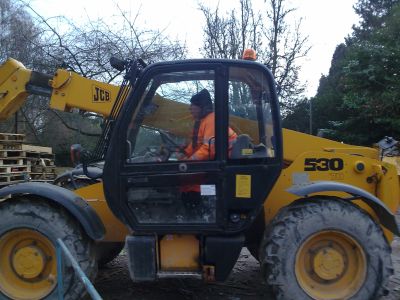
Bob and his new toy!
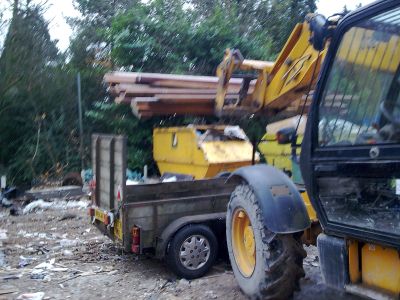
Loading the trailer
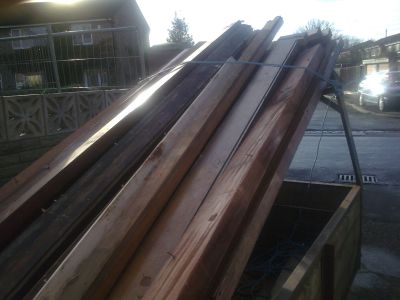
Trailer loaded
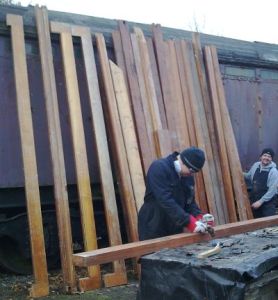
Some of the timber awaiting
de-nailing. prior to storage
de-nailing. prior to storage

Racks and brackets removed and paint scraping
well under way.
well under way.

Guards compartment getting the
same treatment.
same treatment.
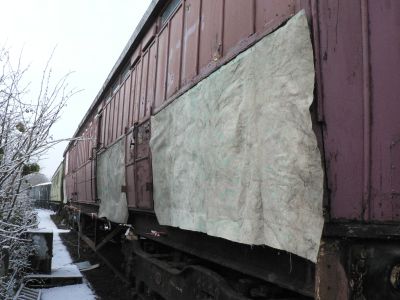
Evidence of the removed panels.
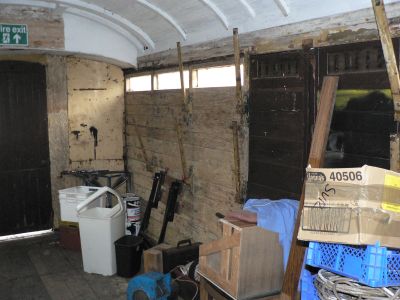
Racks removed but still a number of brackets
still putting up a fight.
still putting up a fight.
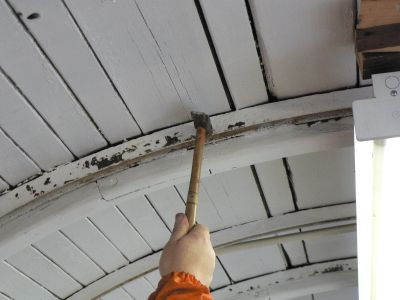
Another task is the removal of rust between the
steel roof hoops and the boards. Which requires
the use of a hammer.
steel roof hoops and the boards. Which requires
the use of a hammer.
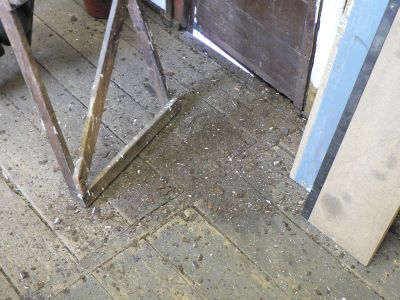
And standing well back as the rust lands on
the floor!
the floor!
January 2010
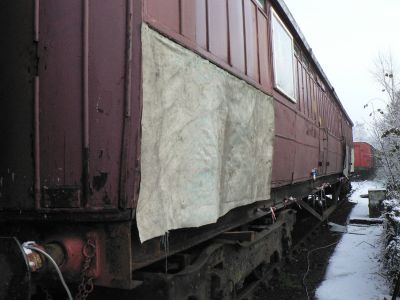
With snow on the ground work outside is limited.
Before Christmas more of the panels were removed during this
exercise two original Teak panels were discovered these have
been put in store, the removal of the rust between the body and
under frame is well under way.
Inside the racks have been removed along with most of the
hinged brackets these have been identified to enable the refitting
of the original racks in the luggage end.
The task of stripping paint from the luggage and guards area
panelling is also underway.
Before Christmas more of the panels were removed during this
exercise two original Teak panels were discovered these have
been put in store, the removal of the rust between the body and
under frame is well under way.
Inside the racks have been removed along with most of the
hinged brackets these have been identified to enable the refitting
of the original racks in the luggage end.
The task of stripping paint from the luggage and guards area
panelling is also underway.
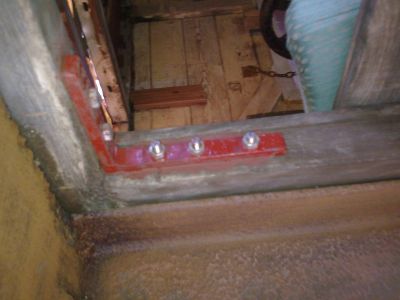
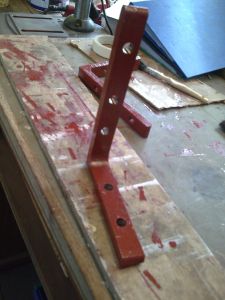
Thanks to Goodturn Engineering
120 brackets have been cut from
donated angle. 40 or so will be used
to replace the life expired frame
Brackets, in the mean time the rest
are going to be used to re fix the
floor joists to the side timbers.
This is the first real bit of restoration
to be performed on 70759.
120 brackets have been cut from
donated angle. 40 or so will be used
to replace the life expired frame
Brackets, in the mean time the rest
are going to be used to re fix the
floor joists to the side timbers.
This is the first real bit of restoration
to be performed on 70759.
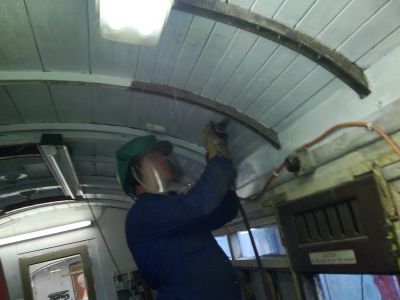
Mean while the task of de-rusting the roof hoops that was started
back in January is continuing.
back in January is continuing.
April 2010
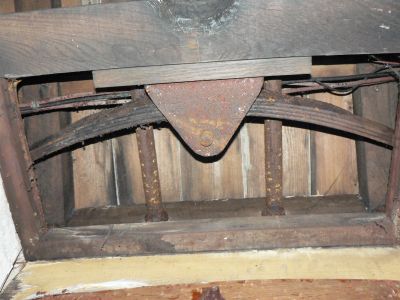
With the ceiling panel removed and retained
for use as a patten, the spring and mounting
bracket can be seen.
for use as a patten, the spring and mounting
bracket can be seen.
Saturday 1st. In preparation of the
removal of the gangway plates.
The removal of the gangway top
springs and the release of the
spring follower flanges gangway
top sliders took place.
With the retaining pin removed
the spring is moved side ways till it
clears the follower this gives room
to slacken to mounting bracket
bolts enough to loosen the
bracket and permit the spring to
be removed.
removal of the gangway plates.
The removal of the gangway top
springs and the release of the
spring follower flanges gangway
top sliders took place.
With the retaining pin removed
the spring is moved side ways till it
clears the follower this gives room
to slacken to mounting bracket
bolts enough to loosen the
bracket and permit the spring to
be removed.

Follower with rest rust
removed
removed
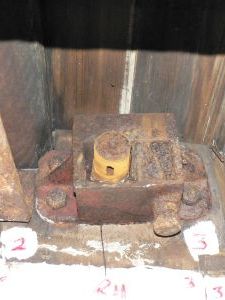
Follower removed, the dry
state of the rust shows
that the releasing fluid
had not got far.
state of the rust shows
that the releasing fluid
had not got far.
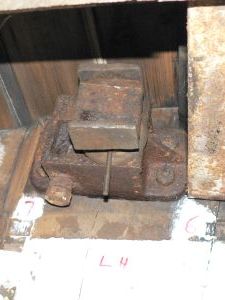
Follower in place with
temporary retaining pin
temporary retaining pin
The spring followers are
the next to go. Of the 4, 3
were easy to remove but
the 4th required a 4” pair
of Stillson wrench. a large
hammer and a jack to
release it from 60 years
of rust.
the next to go. Of the 4, 3
were easy to remove but
the 4th required a 4” pair
of Stillson wrench. a large
hammer and a jack to
release it from 60 years
of rust.
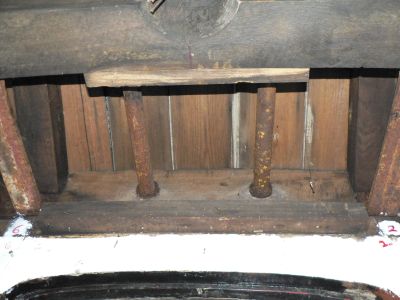
Spring and bracket removed
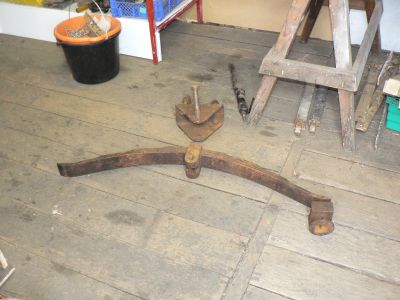
A kit of parts waiting for cleaning and
a coat of paint
a coat of paint
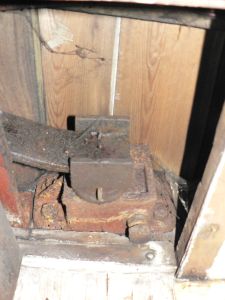
And the spring followers
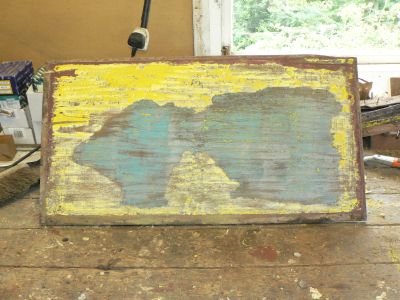
During paint removal a bit of history was
uncovered the paint time line BR silver
undercoat, blue top David and Charles
yellow and SDR maroon paint
uncovered the paint time line BR silver
undercoat, blue top David and Charles
yellow and SDR maroon paint

More evidence of war time build a panel like
this would have ended up in the shop boiler
before the war
this would have ended up in the shop boiler
before the war
May 2010
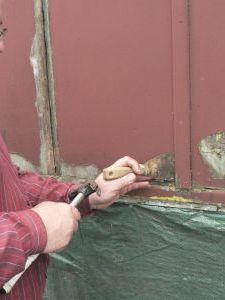
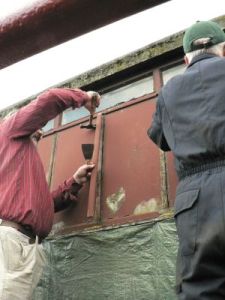
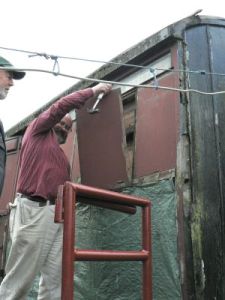
15th Top panels from the
proposed compartment
were removed for
refurbishment these will
be use to replace
damaged ones in the
goods van end.
proposed compartment
were removed for
refurbishment these will
be use to replace
damaged ones in the
goods van end.
The removal of beading both along the top and
between the panels
between the panels
First panel out
June 2010
These photos show our first efforts at restoring teak panels on the 70759.
"Before" illustrates the problem of paint & scorch marks (made by an over enthusiastic blowlamp operator in the
BR era) not showing up until the first coat of varnish is applied. This varnish had to be stripped off, most of the
remaining paint came with it, the panels sanded & 3 coats of fresh varnish applied. Some of these panels came
from the other end of 70759, being only 1/4" thick they are quite prone to damage, & the worst ones were
replaced with better from the other end where the planned conversion work will render them redundant.
"Before" illustrates the problem of paint & scorch marks (made by an over enthusiastic blowlamp operator in the
BR era) not showing up until the first coat of varnish is applied. This varnish had to be stripped off, most of the
remaining paint came with it, the panels sanded & 3 coats of fresh varnish applied. Some of these panels came
from the other end of 70759, being only 1/4" thick they are quite prone to damage, & the worst ones were
replaced with better from the other end where the planned conversion work will render them redundant.
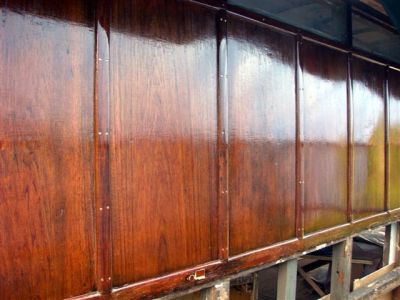
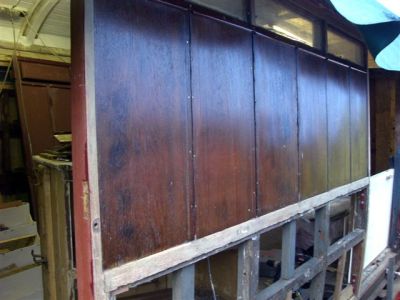
Before
After
September 2010
As the restoration of the short van progresses the economies made due to the war become apparent with the use
of nails in stead of screws, Nuts made from smaller hexagon stock size and in some areas the use of less
durable timber have been found.
The Cant is one such case where a 15ft length was found to be rotten and required replacement.
of nails in stead of screws, Nuts made from smaller hexagon stock size and in some areas the use of less
durable timber have been found.
The Cant is one such case where a 15ft length was found to be rotten and required replacement.
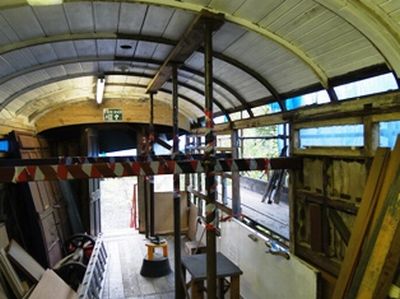
Preparation for the replacement of the Cant
rail the lower 3 roof boards have been removed,
Acros setup to support the roof and cross
braces Installed to support the side frames.
rail the lower 3 roof boards have been removed,
Acros setup to support the roof and cross
braces Installed to support the side frames.
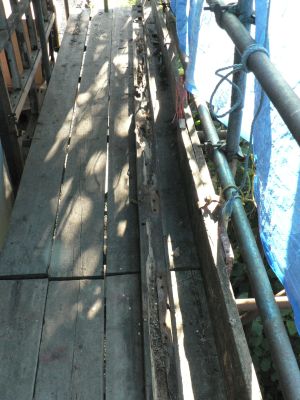
Old section of Cant rail removed
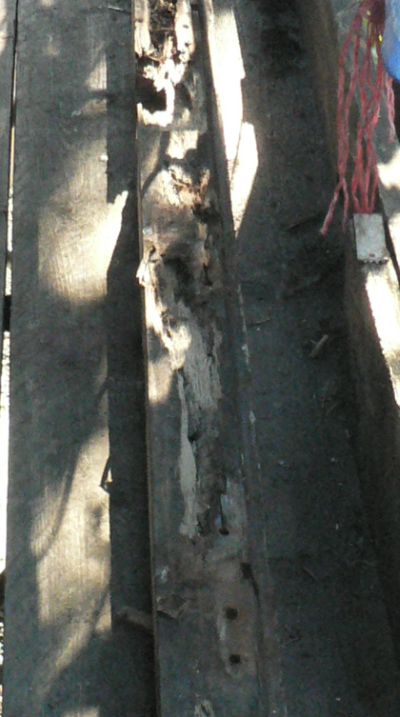
Close up of the rot in the Cant rail
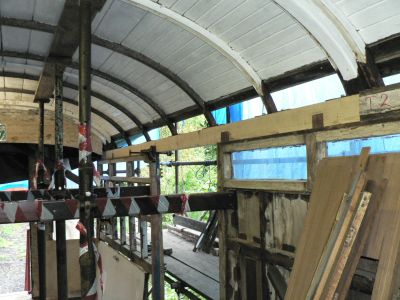
The original Cant rail had a cross section of
4.5” x 4” to facilitate the fitting of the new rail
and to reduce cost it was made in 2 parts
1 of 4” x 3” and 1 of 4” x 1.5”
Shown is the outer section of the rail.
4.5” x 4” to facilitate the fitting of the new rail
and to reduce cost it was made in 2 parts
1 of 4” x 3” and 1 of 4” x 1.5”
Shown is the outer section of the rail.

Trial fit of inner section prior to drilling
for screws and gluing in place
for screws and gluing in place
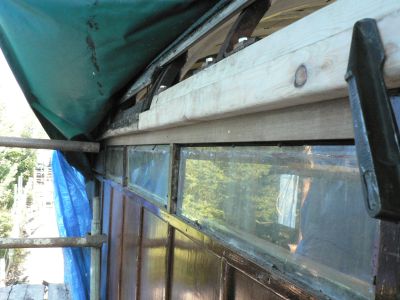
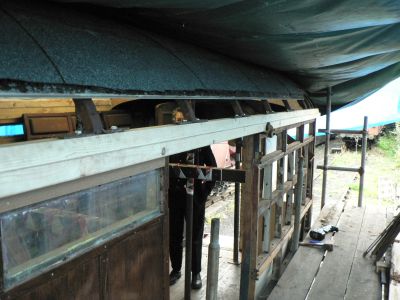
2 view of the new section cant rail in position
October 2010
The replacement of the Cant rail is complete and the restoration of the Guards compartment is progressing.
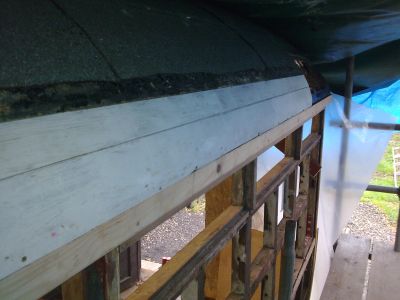

Cant rail completed and the refurbished roof boards fitted.
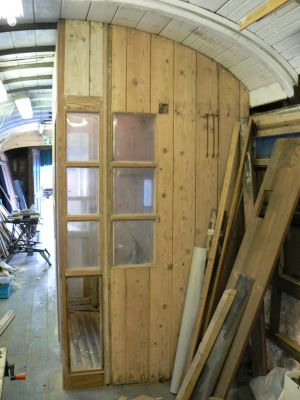
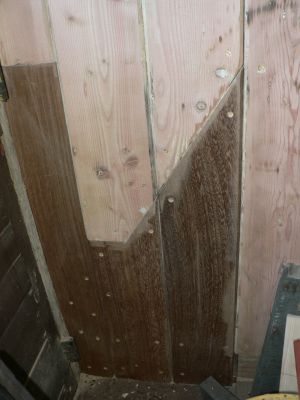
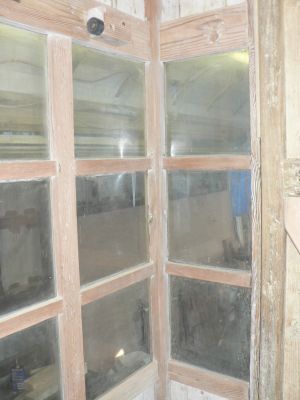
The Guards compartment timbers have had the paint removed and any rotten wood replaced.
Saturday 6th In the absents of teak panels, varnished plywood has been fitted in the gaps where they’ll fit.
Teak is now available from a sustainable source, and we’ll soon be appealing for donations to buy it.
Teak is now available from a sustainable source, and we’ll soon be appealing for donations to buy it.
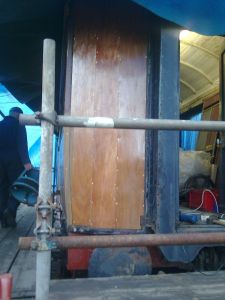
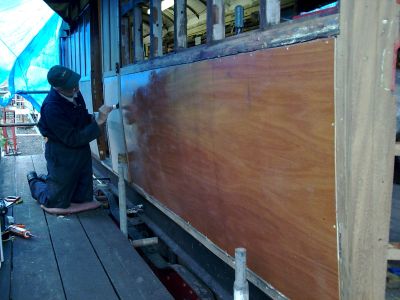
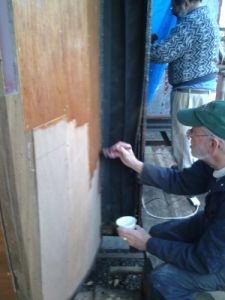
Richard Hill having clamed the only job he capable of was removing paint & varnish, it was suggested he had a go
at putting some varnish on instead. Second coat next week Rich?
at putting some varnish on instead. Second coat next week Rich?
Tuesday 9th Richard Gunning made a visit to the School of Electrical & Electronic Engineering at The University
of Birmingham to collect a car load of the Iroko and Sapele timber that had removed during the refurbishment of
the buildings, On Friday 26th Bob Russell and Mike Cranmore made a second visit this time with a trailer to get
the rest and soon found more visits will be required. This has been made possible by Alan Yates of the University
and his negotiating skills with University management and the construction company Clegg Construction Ltd.
of Birmingham to collect a car load of the Iroko and Sapele timber that had removed during the refurbishment of
the buildings, On Friday 26th Bob Russell and Mike Cranmore made a second visit this time with a trailer to get
the rest and soon found more visits will be required. This has been made possible by Alan Yates of the University
and his negotiating skills with University management and the construction company Clegg Construction Ltd.
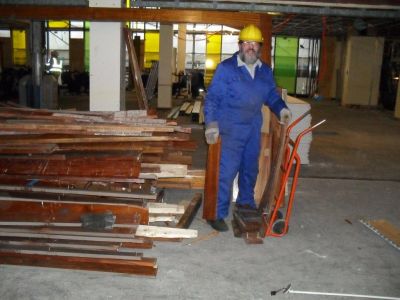
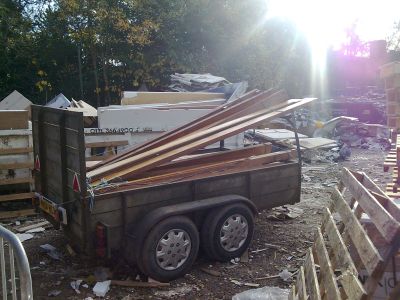
Second visit the trailer loaded up.
Richard next to the pile of wood wondering how
to fit all in a Vauxhall Astra!!!!!
to fit all in a Vauxhall Astra!!!!!
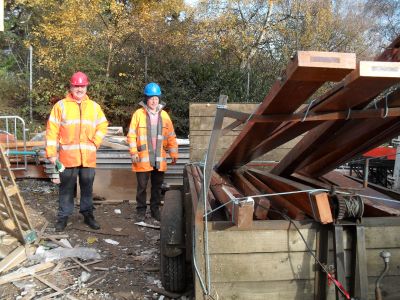
Bob and Mike wondering if they could get
anymore on and the clutch would hold out!.
anymore on and the clutch would hold out!.
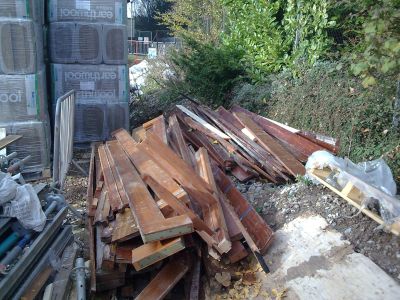
Here is what’s still to be collected as least one
more trip.
more trip.

| Latest Site Updates |
| News Letters |
| GWR Toad 17410 |
| LNER 70759 24506 |
| LNER 70442 |
| LNER 2013 -2017 OVERHAULS |
| GNR 2701 |
| GWR 1145 |
| General Items |
| GWR Toad 17410 Progress 2016 |
| GWR Toad 17410 Progress 2017 |
| Boston Yard Lift |
| Armchair Member |
| Videos |